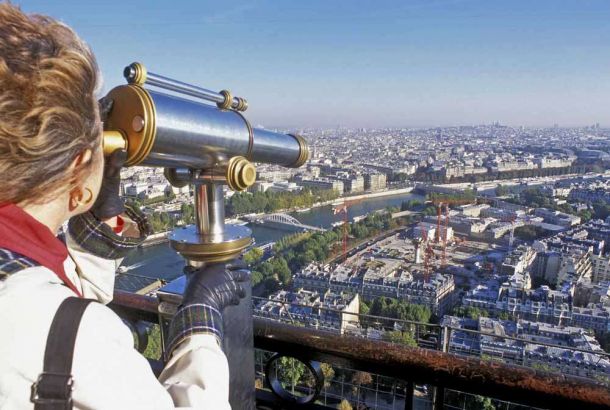Discover the true flavour of this magnificent city in a really fun day out, on a walking circuit that covers all aspects of Paris.
We walked our socks off for a whole day around Paris to really feel the pulse and vibrant rhythm of life that permeates the city (or was it our aching feet), simply by ‘joining up the dots’ of some famous landmarks.
We’d been to Paris many times, either to meet French friends (who have little enthusiasm for touring their own city) or to concentrate on single locations – we could have spent a week in The Louvre alone.
Unlike many cities, Paris is compact with many of its principal attractions all within manageable walking distances. We didn’t want to do a ‘culture, arts or literature tour’ to the exclusion of all else but to really immerse ourselves in the atmosphere and energy of the city as a whole while finding our way past some notable landmarks.

We decided against the burden of a car (driving and parking in Paris is fairly simple but added hassle that curbs both the tendency to walk and to indulge in the Parisian pastime of extended lunch with wine) and opted for a Eurostar trip from London right to the centre of Paris; stopping at Gare du Nord (North Station) which is spitting distance from Le Pigalle and Monmartre.
 We stayed in an hotel that was walking distance from Gare du Nord, simply as a respectable base to walk from as we didn’t intend spending much time in it. If we’d wanted to book into the George V again, then we’d have been reluctant to leave.
We stayed in an hotel that was walking distance from Gare du Nord, simply as a respectable base to walk from as we didn’t intend spending much time in it. If we’d wanted to book into the George V again, then we’d have been reluctant to leave.
The purpose of this post is to tempt you to walk – you know you’re never far from anywhere – and if all else fails (or you delay too long over espresso and pastries or lunch, or your legs give out) there’s always the Metro to whisk you to wherever you wish to go next.
Our map numbers show roughly the order of the route we followed and the pictures give you an impression of the diversity of architecture, culture and experiences that you’ll enjoy. This isn’t a rigid step-by-step guide but deliberately a broad brush suggestion to follow a similar route and to make your own discoveries – it’s all very much part of the pleasure.
By sheer chance– rather than design – the route we followed breaks down into four groups (Architecture, Monuments, Gardens, Arty-Crafty) that give you a really good cross-section of all that Paris has to offer without force feeding you on too much detail or bias to any one area. The route has many little Cafes and eateries that won’t break the budget because you’re a tourist and many are frequented by Parisians going about their daily lives.
Let us know how you get on.
ARCHITECTURE

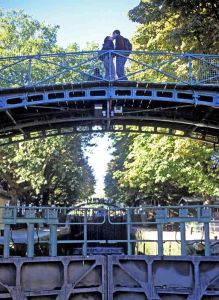 1. Canal Saint Martin
1. Canal Saint Martin
Just a stone’s throw from Gare du Nord and we thought we were in Amsterdam! This picturesque canal reflects the style of its Dutch neighbour with open quaysides flanked by period architecture, whilst young lovers, arm in arm, lean over the sides of the elegant wrought iron footbridges to watch the passengers in pleasure boats that languidly potter through the locks.
Head back to the western side of the canal, down through La Place de la Republique and further south to:
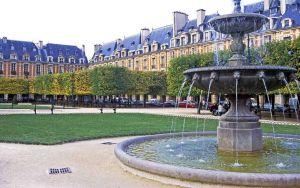
2. Place des Vosges – Paris’ oldest square
The Place des Vosges, inaugurated in 1612 by Henry IV set the scene for all residential squares to come for the aristocracy throughout Europe.
It’s a perfect square, unlike many, at 140m x 140m, and is a beautifully maintained and colourful example of French classical architecture – a real beauty that can’t fail to please.
3. Notre dame
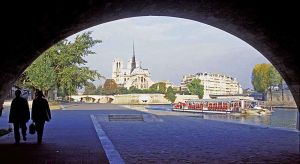
 Leave Place des Vosges in a south-westerly direction and you’ll soon come to the Ile de la Cite where Notre Dame is located.
Leave Place des Vosges in a south-westerly direction and you’ll soon come to the Ile de la Cite where Notre Dame is located.
Marvel at the sheer scale of the buttresses that support the walls and the countless gargoyles that stare down at you to keep evil spirits out.
I don’t think we’ve ever been in!
4. Pantheon
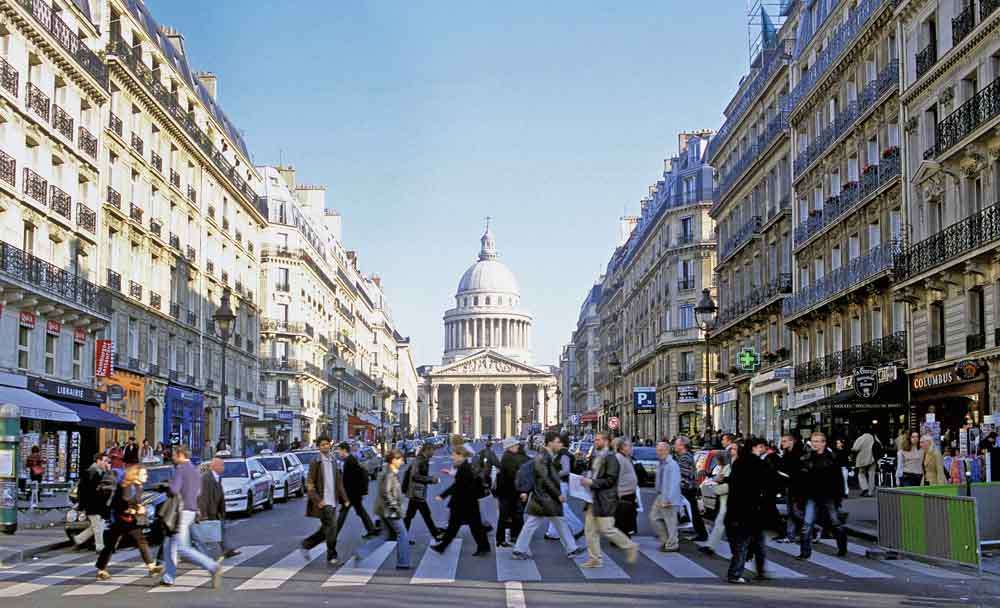

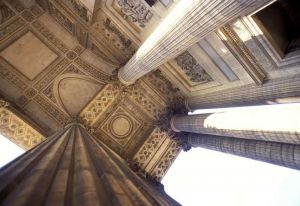 An early example of neoclassicism the Pantheon, in the Latin Quarter, was originally a church but has since become a mausoleum for the great and the good of France.
An early example of neoclassicism the Pantheon, in the Latin Quarter, was originally a church but has since become a mausoleum for the great and the good of France.
With its facade modelled on the Pantheon in Rome it is nevertheless highly impressive in its own right whether you choose to venture inside its cavernous interior or simply to view it at a distance.
5. Rue Mouffetard
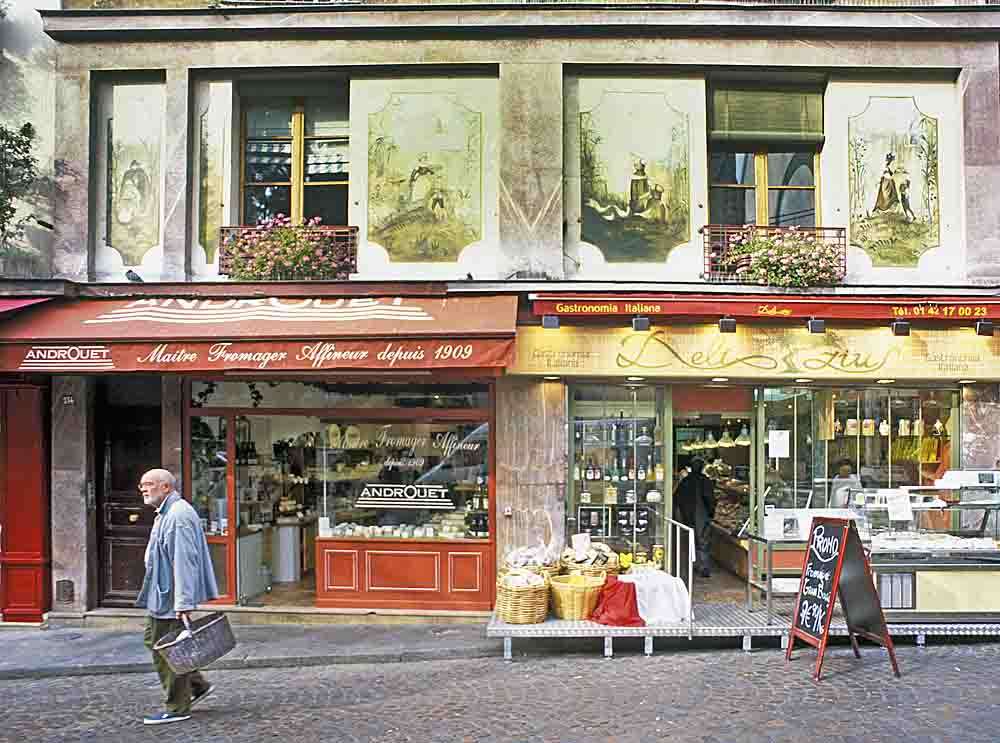
We detoured very slightly, as much by accident as design and found ourselves in Rue Mouffetard, that turns into a quaint street of painted facades and traditional cafes, bakeries, patisseries and shops – well worth the visit to acquaint yourself with some of the less grand but no less impressive styles of Paris – and perhaps to grab yourself a coffee or snack.
MONUMENTAL MEMORIES
6. Catacombs

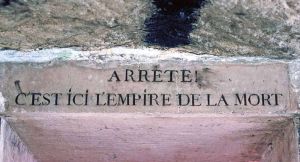 To enter the surface access in Place Denfert-Rochereau there is no indication that you are entering ancient mines that hold the remains of over six million people in a small part of this Paris tunnel network. South of the former city gate “Barrière d’Enfer” (Gate of Hell) the Catacombs utilised the tunnels to resolve the problem of overflowing cemeteries. Remains from cemeteries to the reinforced tunnels were transferred from 1786 to 1788 in a series of night-time processions and were added to thereafter.
To enter the surface access in Place Denfert-Rochereau there is no indication that you are entering ancient mines that hold the remains of over six million people in a small part of this Paris tunnel network. South of the former city gate “Barrière d’Enfer” (Gate of Hell) the Catacombs utilised the tunnels to resolve the problem of overflowing cemeteries. Remains from cemeteries to the reinforced tunnels were transferred from 1786 to 1788 in a series of night-time processions and were added to thereafter.
Admittedly, not on everyone’s wish-list but a totally different dimension to Paris that is hard to assimilate.
7. Eifel Tower
No visit to Paris seems complete without viewing or visiting this imposing ‘pylon’ on the Champ de Mars which is perhaps the most recognisable and certainly the most visited ‘paid’ monument in the world. As it’s en route to other attractions you might choose to sit in the gardens or buzz to one of the top platforms (especially on a clear day) nearly a thousand feet in the air to enjoy Parisian vistas. It’s certainly a huge feat of engineering and its scale, up close, can’t fail to impress – even if you’re sick of the sight of wrought iron if you’ve chosen to climb the steps instead of using the lifts.
Cross the River Seine to the Trocadero, then head for Palais de Chaillot and cross the road to Marshall Foch’s statue, before leaving the roundabout at ‘2 o’clock’ to walk down Avenue Kleber towards the Arc.
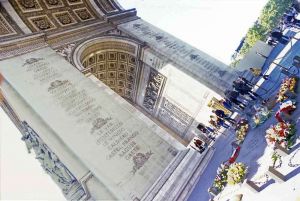
 8. Arc de Triomphe
8. Arc de Triomphe
As well as honouring those who fought and died for France in the French Revolutionary and the Napoleonic Wars and housing the Tomb of the Unknown Soldier from World War I in its vault below, the Arc de Triomphe is the hub of vehiclular mayhem that revolves around it on the Place Charles de Gaulle (previously Place d’Etoile) seeking entry to, or escape from, the twelve ‘spokes’or avenues that feed it. If you’re faint of heart then driving around here can induce apoplexy, whereas braver souls see it as a rite of passage. Pedestrians, fortunately, can use the underpasses.
GARDEN ROUTES

From the Arc, the Champs Elysees forms the principal axis of Paris that leads all the way to the Louvre. It’s easy to be distracted from the gardens and sights along the way by tempting cafes and restaurants but you’ll pay the price if you do as you’re on one of the principal tourist routes as well.
9. Place de la Concorde
 Half way to the Louvre, cross the Place de la Concorde, past the Obelisk of Luxor and attractive Fontaine des Fleuves (Fountains) before again crossing the road towards the museums of Musee de l’Orangerie (impressionist and post-impressionist paintings) and Jeu de Paume (modern and postmodern photography and media) at the entrance to the Jardin de Tuileries. Private gardens to the Louvre for Queen Catherine de Medicis, after the death of her husband Henry II in July 1559, the Tuileries became a public space following the French Revolution and continues to be a place to promenade and relax for Parisians.
Half way to the Louvre, cross the Place de la Concorde, past the Obelisk of Luxor and attractive Fontaine des Fleuves (Fountains) before again crossing the road towards the museums of Musee de l’Orangerie (impressionist and post-impressionist paintings) and Jeu de Paume (modern and postmodern photography and media) at the entrance to the Jardin de Tuileries. Private gardens to the Louvre for Queen Catherine de Medicis, after the death of her husband Henry II in July 1559, the Tuileries became a public space following the French Revolution and continues to be a place to promenade and relax for Parisians.
ART & OTHER ANTICS

What an enigma – tour Paris or stay in The Louvre forever?
10. The Louvre
If this is truly a long-day’s walk then you’ll do little more than view the fantastic façade of the Louvre and the counterpoint of the glass pyramid before moving on – because once you enter the labyrinthine halls of its enormous galleries you might never be seen again as you immerse yourself in some of the most monumental art the world has ever produced.
TIP: If you’re tempted to go in, then don’t queue but go to the Office du Tourisme (Tourism ticket office) at the corner of Rue des Pyramides and Rue de Argenteuil (ten minutes’ walk away from the Louvre, to the north) where you can purchase tickets and then completely by-pass the enormous queue outside the Louvre.
If you’ve just come out of the Louvre you’ll probably be completely exhausted by now but if you’ve got the time then why not tack on a couple of extra sights that are well worth the effort but will be a bit of a hike?
Alternatively you might decide that first its time for another refresher, so why not take the weight off and listen to a street orchestra or browse some of the modern art shops behind the Louvre

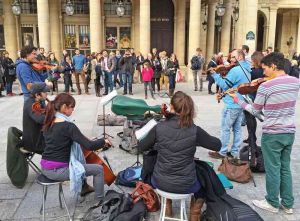

11. Moulin Rouge & Le Pigalle


This needs no introduction but nevertheless is worth the visit – not for the seedy side of the red light district but for the spectacle of the brightly lit windmill of the Moulin and the kitsch fetish and fantasy kit in the shop windows at night – it’s just part of Paris.
Its a bit of a stretch from the Louvre to here, a good hour’s walk northwards – so you might decide to freshen up in your hotel and venture out again in the early evening, when this part of Paris comes to life.
12. Montmartre
Le Pigalle is also on the route to Montmartre, the original artist’s district that still flourishes because of the thousands of tourists who venture there and come back clutching a portrait of themselves. The original artists can’t afford to live here now.
Avoid this part and explore the narrow cobbled streets of one of the most historic and interesting neighbourhoods of Paris. As long as you’re going uphill you won’t get lost for long as you’ll inevitably arrive at the top – the Sacre Coeur
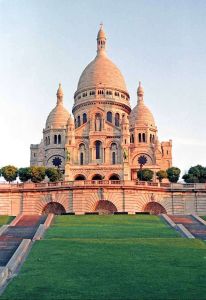

The Basilica of the Sacred Heart sits atop the hill as a white beacon for all Parisians and is now mainly visited by young lovers in the evenings who sit holding hands gazing out over Paris.
It’s the best time to visit if you want to avoid crowds of tourists and a great place to survey the wonderful city that you’ve just exhausted yourself by walking around, as the Sacre Coeur bathes you in a reflected floodlit aura.
If you’ve walked the complete route that we’ve covered here then you’ve had a truly amazing insight into the character, culture and lifestyles of Paris. We don’t think there’s any better way to experience what Paris has to offer – we do hope you agree, once you’ve recovered!
![]()

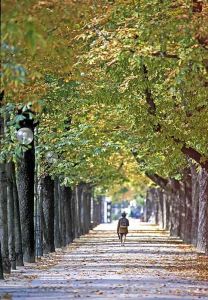
If you fall at any hurdle and want to ride part of the way then why not try the Metro (or Metropolitain, as some of the old Art Nouveau styled stations are still signed).
It’s a big efficient underground system and will whisk you to wherever you want to go, as long as you pay attention to the metro map and guides at every station.
You can buy tickets at any station and be sure to differentiate between Metro and RER (which is the suburban/commuter rail that takes you to and from the suburbs as well as parts of central Paris).
If you’d like to download your own map for personal use then go to this link for the RATP
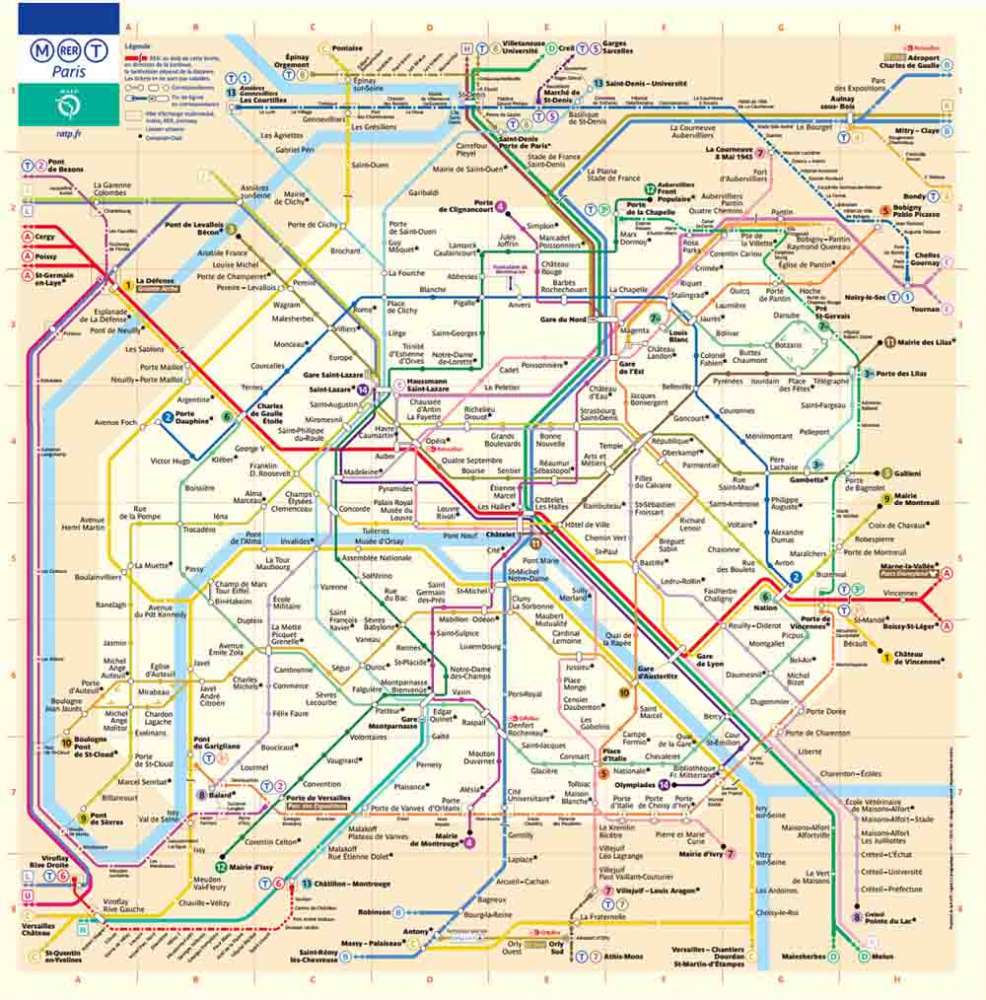
It’s all fairly clear when you get there – the RATP map here shows you the overall network, but you can easily get maps at the station and staff are really helpful.
It’s all part of the adventure!





